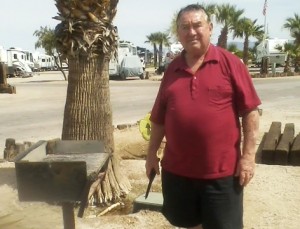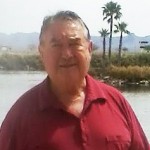6/19/14
What it’s like to see with the CentraSight telescope implant
Like many people, I’ve set goals in my life, both professionally and personally and like being an active and engaged member of my community and my country. I love to teach: I taught history, geography and special education for years in Banning, California and now live in Moreno Valley, California, with my wife of 32 years, Kay. I love my country: I’m a proud veteran of both the Army Reserve and the Navy. And I love an open road. My wife and I traveled the country visiting historical monuments in our 32-foot RV. I guess I’ve got what you’d call a real zest for life. But, over the past twenty years, all the things I enjoyed doing in my life, even the simple day-to-day activities, started to decline because I was slowly losing my vision due to age-related macular degeneration. For example, six years ago, my wife took over all the driving because I couldn’t see well enough to drive safely.

That was a real turning point for me. My wife had to help me so much because I just couldn’t see. I needed help shopping because I couldn’t read labels. I started to avoid social situations, like visiting with friends because I was embarrassed that I couldn’t recognize faces any longer. As you can imagine it was heartbreaking for both me and my wife.
But then my doctor told me about a treatment I wasn’t yet aware of called the telescope implant. The device is very small (smaller than a pea!), and it is implanted in one eye to restore vision. My doctor explained that it works like a real telescope in that it magnifies images, which reduces the effect of the blind spot on my straight-ahead vision. The other eye does not get an implant because you need to keep some peripheral vision to help with orientation and balance. This sounded like science fiction! But I wanted to see if it could help me and I decided to give it a try.
I worked with a great team of specialists, who were part of a treatment program called CentraSight. My retina doctor, cornea surgeon, low vision optometrist and a low vision occupational therapist all counseled me about what to expect from the outpatient procedure, particularly afterwards. For example, I learned there was a significant amount of occupational therapy required to adjust and become proficient at using my new vision. I also was warned that my sight would not be like it was in my youth. I wouldn’t be able to do everything I used to nor would I be able to see, differently, the minute I opened my eyes.
I had my surgery in early 2013. The cost for the telescope implant and visits associated with the treatment program were covered by Medicare, which was very helpful. Thinking back, I was nervous on surgery day, but afterwards, I was told by my occupational therapist that I was one of the quickest to recover from surgery. I give lots of credit to my OT folks as well as my wife who helped me with the exercises at home. The most amazing part is being able to see my wife’s face again for the first time in six years! I’ve regained the ability to do many everyday tasks, like reading, working on my computer and watching old Westerns on TV. My wife and I are even back to traveling the open road in our RV (which she drives)!
I would recommend people learn more about the telescope implant to see if it might help them, the way it helped me. There are CentraSight teams across the country. When you call 1-877-99-SIGHT or visit www.CentraSight.com a trained CentraSight information Specialist will point you to the team closest to your home and can even help schedule the appointments for you. The telescope isn’t for anyone, but it can make such a difference in your life. It certainly did in mine.


